In this first online exhibit presented as part of our edition of key documents, we highlight Jewish history after the Holocaust and National Socialism. As is the case with the sources presented on our website, Hamburg’s Jewish history here serves as point of departure in order to examine broader developments and questions in German-Jewish history. In addition to a thematic-chronological (vertical) narrative, the online exhibit also offers the option of delving deeper into specific aspects by thematic chapters (horizontal) and thus find connections between individual sources.
When the first Jewish congregations were formed in West Germany immediately after the end of the war, as was the case in Hamburg in summer 1945, this was by no means uncontroversial. It took several decades, however, until Jewish life in Germany was to became self-evident – both for the Jews living there and for the non-Jewish majority society. Just how fragile their relationship was is reflected by the very slow development of a permanent infrastructure – it was only in the early 1960s that a synagogue was dedicated in Hamburg – as well as by the continuing prejudice and antisemitic attitudes among the West German population. Jewish life received new impulses by the influx of so-called quota refugees [Kontingentflüchtlinge] from the former Soviet Union in the early 1990s, which has recently led to a pluralization and (religious) diversification of congregations.
At the end of the war there were about 15,000 German Jews on German territory, several thousand of whom had survived in hiding. Most of them had managed to survive because they lived in a so-called “privileged mixed marriage” [„privilegierte Mischehe“] (if the wife was Jewish or if the children were raised as Christians), which protected them from deportation in most cases. About 9,000 Jews who had survived ghettos and imprisonment in a concentration camp outside Germany or in the German-occupied territories such as Theresienstadt returned as well. In addition, there were Jewish Displaced Persons (DP) from eastern Europe, whose number was 53,000 in September 1945. The number of Jewish DPs on German territory grew further, and they came to constitute the largest Jewish group on German territory after the end of the Second World War, concentrated mostly in American-occupied Bavaria. In northern Germany, Bergen-Belsen was the largest center. For most of these DPs Germany was no more than a transit stop. Yet not all of them actually immigrated to the state of Israel founded in 1948 or to the United States. Many remained in Germany, where they founded the first new Jewish congregations. However, the wish to emigrate often continued to persist for a long time. In Hamburg there were 647 Jews after the end of the war in 1945, almost all of them part of a “mixed marriage.” A further 50 or 80 individuals had survived persecution and war in hiding or by assuming a false identity. (Source: Introductory Text: Demographics and Social Structure)
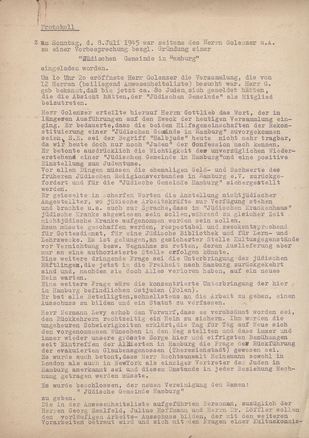

On July 8, 1945, a Sunday, twelve Hamburg Jews gathered in the apartment of Chaim Golenzer at Rutschbahn 25a, a so-called “Judenhaus,” with the intention to reorganize the congregation that had previously been eradicated by the National Socialist regime. They were all former members of Hamburg's German-Israelite Congregation. The meeting was opened by Josef Gottlieb, who had probably initiated the founding of a new Jewish congregation in Hamburg. However, those present were not the only ones interested in a reorganization of the former congregation. The meeting's minutes of July 8 mention roughly 80 Jews who had “been in touch.” Read on >
Three years after the end of Second World War, on September 13, 1948, Heinrich Alexander, a Berlin Jew who survived the war in emigration wrote this letter to the head of Hamburg’s Jewish congregation. In his brief letter he explained that he did not want to remain in Berlin and asked Harry Goldstein, the head of the Hamburg congregation to support his relocation to Hamburg. A couple of weeks later Goldstein replied. In his letter Goldstein explained that because of the housing shortage and the difficulties to receive a residence permit for Hamburg he would not be able to help, and he asks Alexander to reconsider his plan. Read on >

After the end of the Second World War only few Jewish men and women returned from exile to Germany. The same is true for the media sector which was to be newly organized under the supervision of the respective Allied occupation forces after the collapse of the “Third Reich.” Walter Albert Eberstadt (1921–2014), son of Jewish parents and a former student at Hamburg's Johanneum school, was one of the few Jewish returnees who participated in the rebuilding of German radio broadcasting. Eberstadt's access pass issued on February 23, 1946 illustrates that he was a so-called “returnee in uniform,” i. e. a refugee who came back to Germany as an employee of the British occupation authorities. Read on >
In this letter of November 25, 1946, the board of Hamburg's Jewish congregation, which had only been formed about a year earlier, appeals to all members to participate in its religious and cultural activities. On the one hand, this document shows that the congregation had successfully established itself, on the other hand it also reveals the discrepancy between a congregation that was conceived as an Orthodox uniform congregation and its membership. Moreover, the letter illustrates that the congregation felt pressure to justify its existence both within Germany and from abroad.
In addition to the housing shortage, the difficulties encountered in everyday life also extended to finding (kosher) food, including kosher meat. As Rabbi Joel Halpern, member of the Council of the Chief Rabbinate of British Zone, explains in his reply to the chairman of Hamburg's Jewish congregation, Harry Goldstein, a shohet carrying out kosher butchering was available to the Jewish congregation once a week. Kosher butchering, or shechita, had only been permitted again in Hamburg in March 1946. The mayor's notice to this effect included the condition that as little pain as possible must be inflicted on the animals. The correspondence also shows how difficult it was to organize the shohet’s travel from Bergen-Belsen to Hamburg and the role aid organizations such as the American Joint Distribution Committee or the British Relief Unit played in providing for Jewish communities in postwar Germany. Both organizations soon expanded their support of Jewish DPs to include German-Jewish survivors and the fledgling Jewish congregations as well.
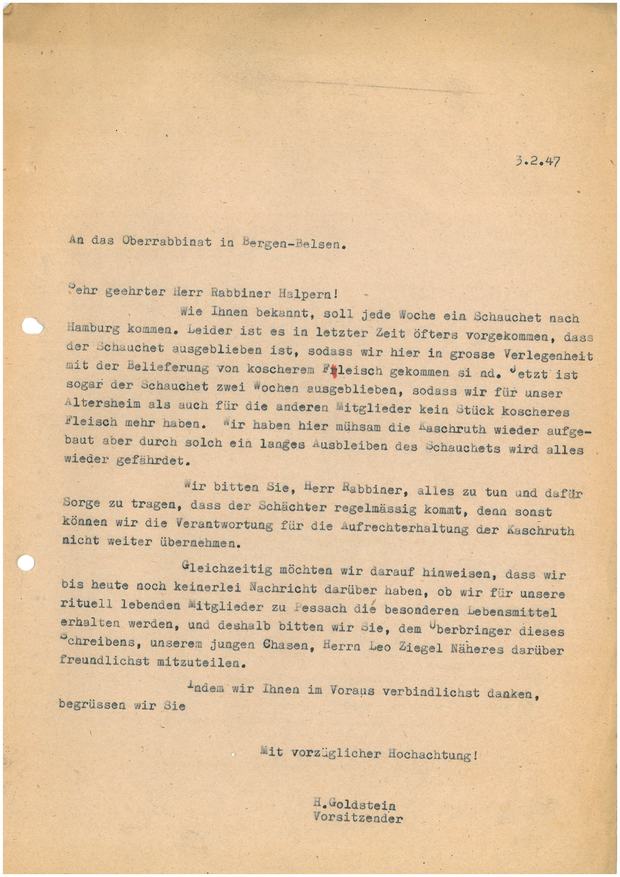

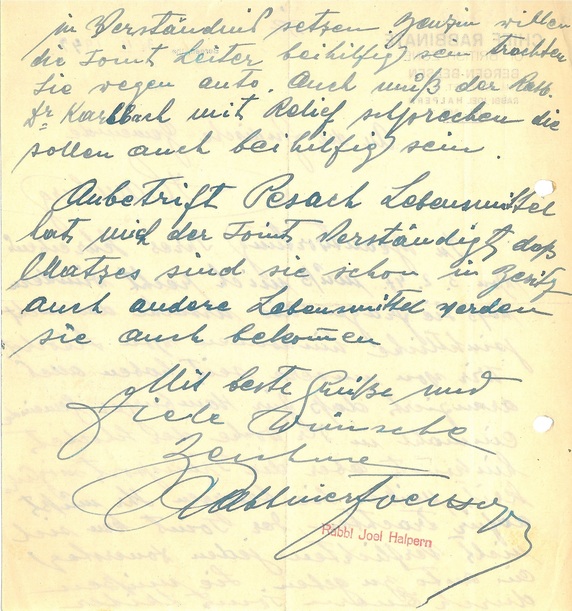
The image shows Austrian-German Jewish actress Ida Ehre, who founded the second Kammerspiele theater company in 1945, leading it to become one of the major stages in postwar West Germany. Despite all the challenges arising with currency reform, she led the theater for more than four decades until her death. Read on >
On March 17, 1948 the cultural office of the Central Committee of Liberated Jews in the British Zone in Bergen-Belsen sent this reply to an inquiry it had received from the fledgling Jewish congregation in Hamburg, who had asked for support in establishing a youth group. The list of items the cultural office could offer to the congregation for this purpose – such as a soccer ball or four table tennis paddles – illustrates the supply shortages shaping (Jewish) everyday life.
Contrary to the widespread view that the most recent past was not commemorated in the period immediately after the end of the war, the surviving manuscript of this speech given by Norbert Wollheim proves that events to commemorate the victims of the National Socialist policies of persecution and extermination were held as early as 1948. In his speech given on November 9, 1948 at a “commemoration ceremony on the occasion of the 10th anniversary of the beginning of the pogroms in Germany,” Wollheim addressed Hamburg's Jewish community, and his speech was subsequently published by the cultural office of the Central Committee of Liberated Jews in the British Zone in Germany, whose deputy chairman Wollheim was at the time.
In his speech he refers to the pogrom of November 9, 1938 as the Tisha B’Av in modern Jewish history, thus contrasting the “cruel end” with the “decades of flourishing” that preceded it. His speech is marked by a spirit of reconciliation: “Yet this is not the hour to accuse, it is the hour to reflect.” He refers to the importance of memory in Judaism and reminds his audience that the victims must be remembered.
Wollheim was actively engaged in the rebuilding of Jewish life in Germany in the immediate postwar period, and he publicly campaigned for the remembrance of Jewish victims. He came to play an important role in several court trials, especially against IG Farben.

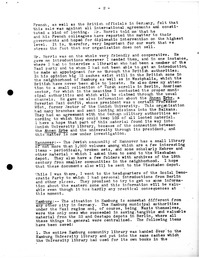
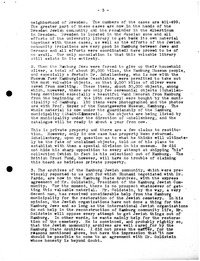
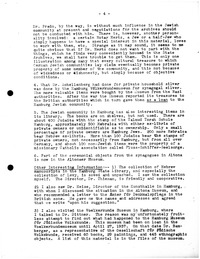
In late 1949, Hannah Arendt traveled to Germany for four months, during which time she visited the British occupation zone in order to survey restitutable cultural assets in the cities of Hamburg, Hannover, Köln, and Lübeck. In Hamburg in particular, she found numerous collections previously confiscated by the Nazis whose legal heirs had yet to be determined.
During her trip, Arendt wrote five official reports for Jewish Cultural Reconstruction, Inc. (JCR) which were distributed to all its board members once they reached New York. These were internal communications not intended to be made public. They give an insight into the extent of Jewish organizations’ activities in dealing with the aftermath of the Holocaust and attest to the difficulty faced by Jewish advocates in their fight for the reinstatement of the rule of law and justice after 1945. Read on >
It was probably in 1956 that plans made by Hamburg's Jewish congregation, re-established in 1945, for building a new synagogue with a community center at Hohe Weide became concrete. In order to find an architect and an appropriate design, the congregation held a competition. The plan presented here is the design submitted by Frankfurt architect Hermann Zvi Guttmann. Read on >

This postcard delivering New Year's greetings shows the main synagogue of Hamburg's Jewish congregation located at Bornplatz. Designed by architects Ernst Friedheim and Semmy Engel and dedicated in a grand ceremony in September 1906, it was the city's first free-standing synagogue, which expressed a new level of confidence among the Jewish congregation. Built in the Romanesque revival style and featuring a dome 40 meters high, the synagogue seated 700 men and 500 women. In addition, there was a day or winter synagogue and a mikvah.
During the 1938 pogrom, the synagogue was severely damaged, and in 1939 the Jewish congregation had to pay for its demolition and sign over the property to the city of Hamburg. Following the demolition, an air raid shelter was built on one part of the site, the remaining space was used as a parking lot until the 1980s. It was only after demands made by a citizen's initiative that the square was redesigned as a place of commemoration. Based on a design by artist Margrit Kahl, the outlines of the synagogue's arched roof have been visualized. The square was then renamed after the Jewish congregation's last chief rabbi, Joseph Carlebach.
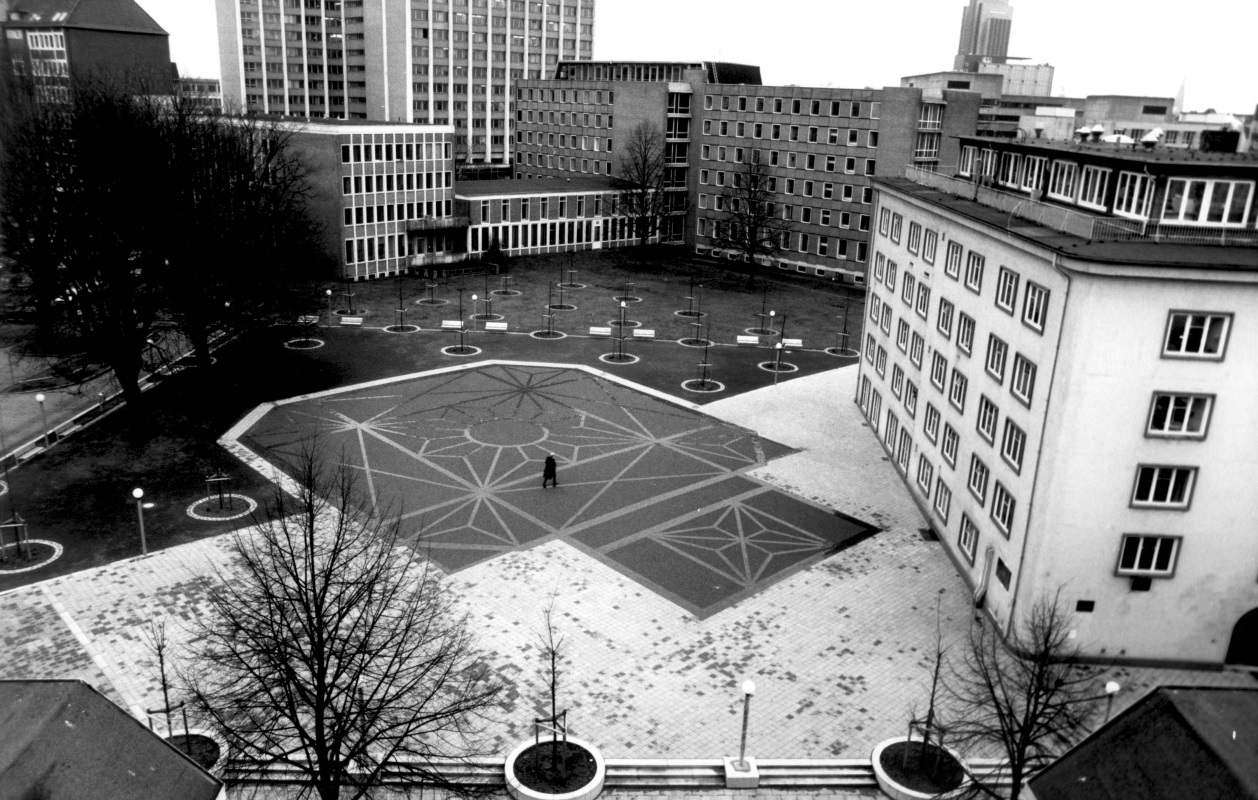
When the foundation stone of the new synagogue was laid on November 9, 1958, Hamburg’s mayor, Max Brauer, was present to give a speech. Hamburg’s first synagogue of the postwar period was built at Hohe Weide. Previously the small Jewish congregation had to hold prayer services in provisional prayer halls. In his speech, which was about twelve minutes long, Max Brauer commemorated the persecution and murder of Hamburg’s Jewish citizens during National Socialism and honored the efforts made to rebuild Jewish life after 1945. Read on >
In the late 1940s the first Jews from Iran came to Hamburg to establish postwar Germany’s only Persian-Jewish community. The majority of them came as merchants selling spices and rugs. In the following decades Hamburg's free port thus became one of the most important trading hubs for the European rug trade. Beginning in the 1950s, prospering trade in the Speicherstadt commercial district led a growing number of Persian-Jewish families to settle in Hamburg, and their community grew further following the Iranian revolution of 1979. The life of this community numbering between 200 and 300 individuals was centered in the Western part of the city, where families resided in the neighborhoods along the outer Alster. The strong social cohesion within this group was shaped by a conservative to traditional understanding of Judaism (which was practiced especially by families from Mashad). These families belonged to Hamburg’s Jewish congregation and attended prayer services at the Hohe Weide synagogue together. read on
They invited each other for Shabbat and for the Jewish holidays, and they maintained close relations within their group. At the same time Persian Jews actively participated in Jewish community life. They followed the rites during prayer services, and a cantor educated in Tehran recited from the Torah for many years. The many Persian rugs in the synagogue's interior, which this photo shows during the celebrations on the occasion of the synagogue’s 50th anniversary, testify to both their influence on congregational life and their generosity with donations. Many Persian-Jewish women were active in the congregational activities organized by WIZO (Women’s International Zionist Organization) while their children attended the youth center.
At the end of the 1980s the first families began to leave Hamburg and migrate again. Their destinations were Los Angeles and New York, the two cities in the United States that were home to the largest Persian-Jewish diaspora communities worldwide. In the course of the 1990s the community of Persian Jews shrank to about 30 individuals while Hamburg’s Jewish community underwent another change, this time due to the influx of Russian-speaking Jews from the Soviet Union and its successor states.
(Text: Karen Körber)
Early opinion polls carried out in Germany show that after the end of the war, antisemitic attitudes, now “privatized,” continued to exist among large segments of the population; they manifested themselves in vandalism of cemeteries, graffiti, and verbal insults. On the one hand, “post-Auschwitz antisemitism” still bears all the characteristics of “classic” antisemitism. Yet the forms it took underwent a change since antisemites now had to react to the genocide either by denial, by rejecting responsibility or by projecting guilt onto the Jews or the state of Israel. These projections were often linked to earlier conspiracy theories in the wake of the publication of the “Protocols of the Elders of Zion.” While public expressions of antisemitic convictions were proscribed in the Federal Republic, they repeatedly caused antisemitic scandals in the early postwar years and into the late 1950s because the courts showed little willingness to prosecute such deliberate insults and the public openly displayed their antisemitic attitudes during court trials, for example by ovations for film director Veit Harlan, who was put on trial in Hamburg for his Nazi propaganda film “Jud Süß” but was eventually acquitted. (Source: Introductory Text: Antisemitism and Persecution)


In early 1957, Hamburg timber merchant Friedrich Nieland distributed a 39-page brochure titled “How Many World (Money) Wars Must the Peoples of the World Lose? Open Letter to All Government Ministers and Members of Parliament of the Federal Republic.” His “open letter” consists of a collage of quotes and illustrations taken from publications by various authors, some of them obscure, some serious. Nieland joins these together by passages of his own writing in which he declares the Holocaust the work of Jews and characterizes “the international Jews” as some sort of secret government steering world politics. Both Nieland and his nationalist publisher Adolf Ernst Peter Heimberg were charged with anti-constitutional acts and libel, but a full trial was never held. In 1959, the brochure was confiscated by the Federal Court of Justice (BGH) due to its seditious content. Read on >
Following the defacing of the Cologne synagogue with swastika graffiti during the night of December 24, 1959, which was widely reported by the media at the time, a number of copycat incidents occurred all over the Federal Republic of Germany – including in Hamburg. The police report of February 1960 lists 74 cases alone up to that date, which included antisemitic slurs and swastika graffiti in public places. These photos from the Conti Press archives show doorbell panels at Bellealliancestraße in the Eimsbüttel district; names assumed to be Jewish have been defaced by swastikas.
As a consequence of these incidents, in summer 1960 a draft law against demagoguery, which had existed since the Nieland case and was thus also referred to as “Lex Nieland,” and a revision of the statutory offense of displaying unconstitutional symbols were passed.
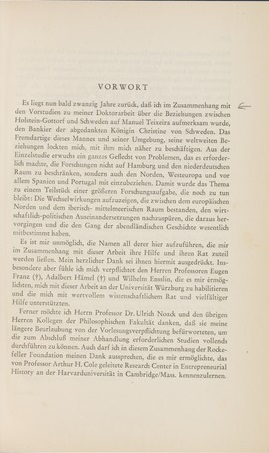
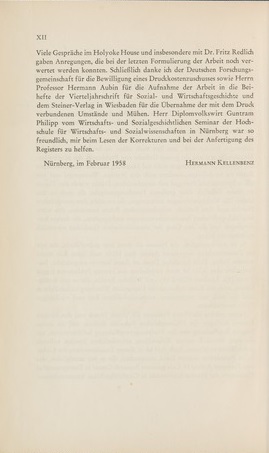
The study “Sephardic Jews on the Lower Elbe” published by Franz Steiner Verlag in 1958 as volume 40 of their supplement to the academic journal Vierteljahresschrift für Sozial- und Wirtschaftsgeschichte (edited by Hermann Aubin) may be considered a central contribution to Hamburg’s Jewish history of the early postwar period. Its author, Hermann Kellenbenz, was one of the most influential German economic historians of his generation. In his 600-page book, he studied the economic significance of the Sephardic Jews who were expelled from Spain in the early 16th century and had been allowed to settle in Hamburg. However, the publication’s origins date back to the National Socialist period, when Kellenbenz had received a research assignment by the Reich Institute for the History of the New Germany . This fact is omitted in the study’s preface – which is hardly surprising for this time period. Read on >
In the spring of 1964, Helmut Schmidt, Social Democrat and Senator for Interior Affairs in the city state of Hamburg, who also served as a board member to the Society of Christian-Jewish Cooperation in Hamburg, learned that the local Protestant church was engaged in missionary work among Jews. This was cause for concern for both Schmidt and the Jewish community. He contacted the Protestant-Lutheran Bishop of Hamburg, Dr. Hans-Otto Wölber, personally in order to gather information on the matter and expressed his criticism of missionary work of any kind among Jews. Read on >






Arnold Bernstein was born in the Silesian town of Breslau on January 23, 1888. At an early age, he moved to Hamburg, where he and his father, merchant Max Bernstein, started a small trading business. After his service in the First World War, for which he was decorated with the Iron Cross First and Second Class, he married in spring 1919 and founded the shipping company “Arnold Bernstein,” which was to make him one of the most successful shipping company owners of the interwar period.
After his arrest by Nazi authorities and the Aryanization of his company, Bernstein and his wife managed to emigrate from Germany to the United States in 1939. In the U.S. he not only fought for compensation from the German government, but he also sought to once again gain a foothold in the shipping industry by founding the American Banner Lines.
Arnold Bernstein died in Palm Beach, Florida on March 6, 1971.
This image from the 1920s shows a car being loaded onto a ship by means of a special lift. Bernstein rejected the traditional use of wooden crates for shipping automobiles and thus revolutionized their transport from the United States to Europe.
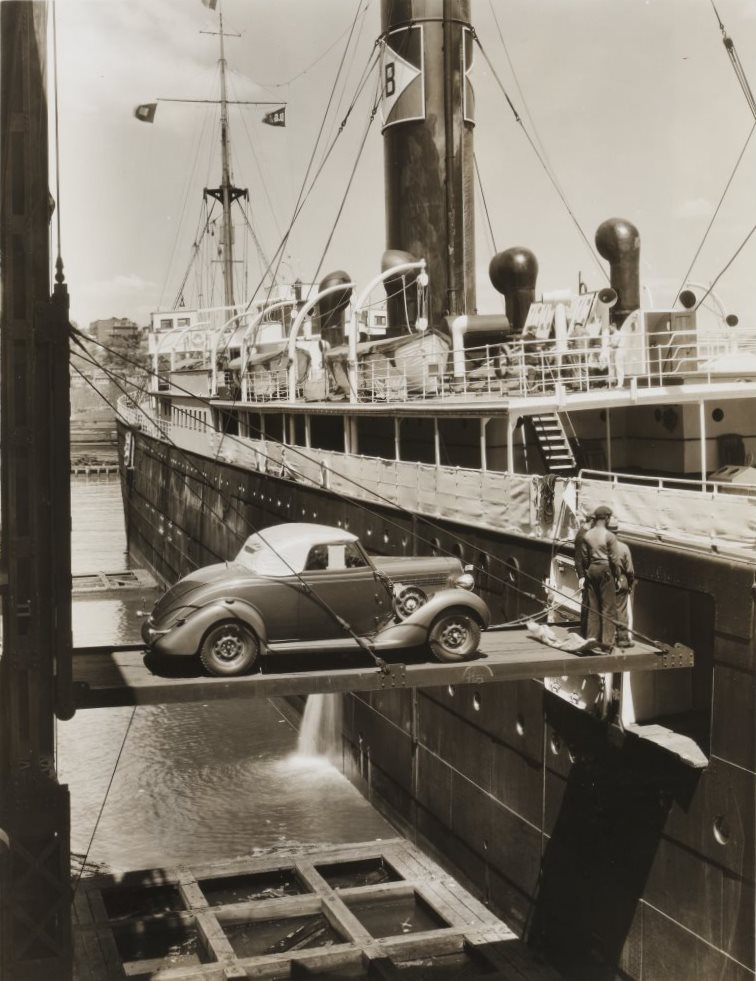
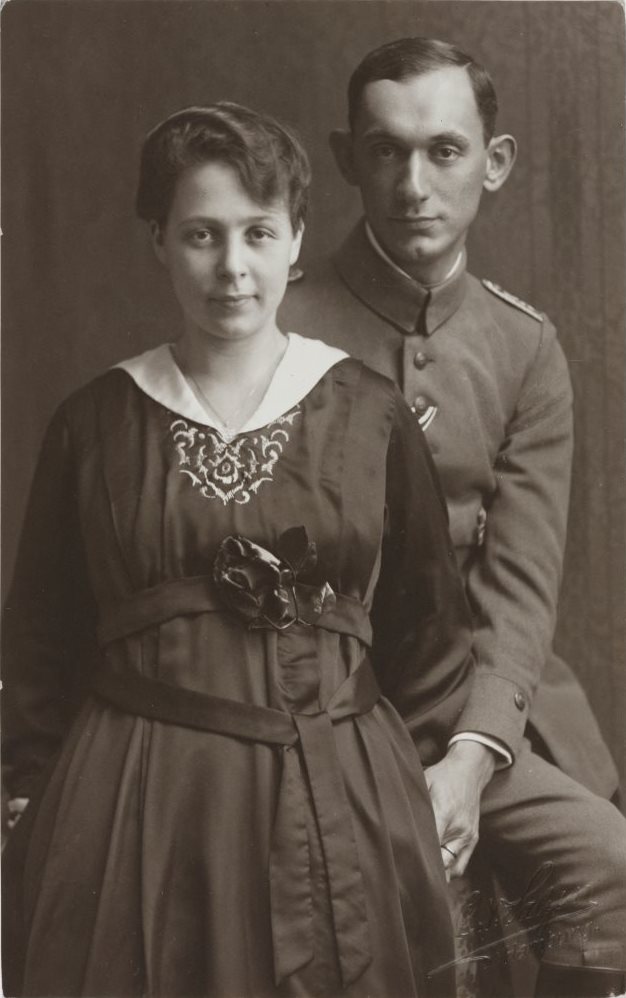
Lilli Kimmelstiel and Arnold Bernstein met in Hamburg and married shortly after the end of the First World War in 1919. They had two children.
The second photo shows the couple in the 1960s.
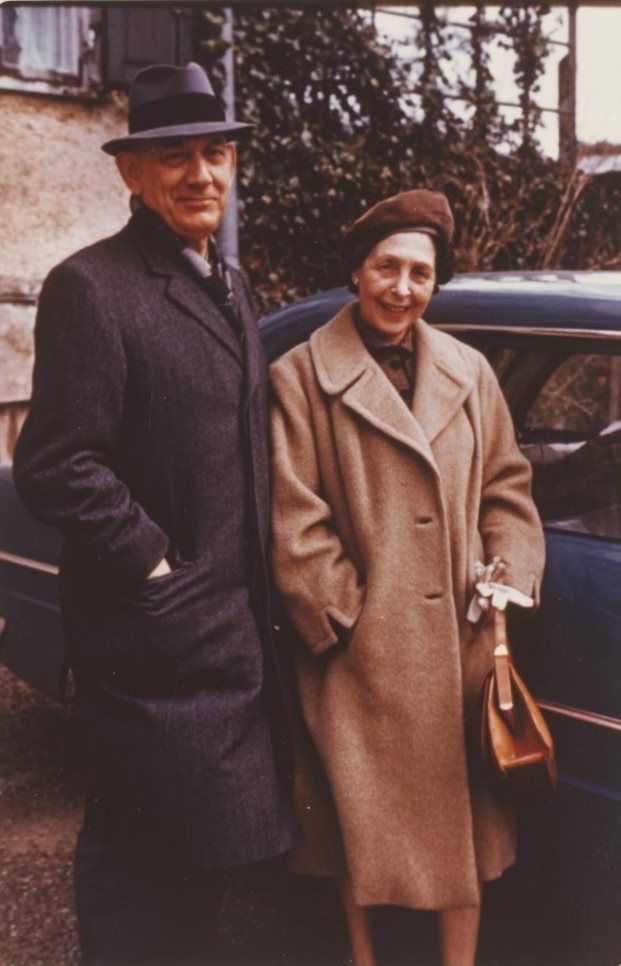

This newspaper article titled “Gespräch mit Arnold Bernstein” [“A Conversation with Arnold Bernstein”] covers the life and work of the German-Jewish shipping company owner from Hamburg. It tells the life story of this Hamburg citizen who in the interwar years had risen to become one of the most successful shipping company owners in the Weimar Republic through his business, Arnold Bernstein Shipping Company, LLC. After the National Socialist takeover in Germany, he was robbed of his entire assets and imprisoned; after spending two and a half years in prison, he managed to emigrate from Germany to the United States in 1939 shortly before the beginning of the war. To the author of this article, Bernstein's efforts to found a U.S. shipping company named “American Banner Lines” symbolize his will to succeed and to live, as the article's subtitle demonstrates: “Former major Hamburg shipping company owner also makes it in New York.” Read on >
The “Atlantic” was meant to be the flagship of the American Banner Lines, symbolizing Bernstein’s hopes for a new beginning in the USA. However, the ship was sold again in 1959, shortly after this photo of Arnold Bernstein was taken.

Walter A. Berendsohn, considered the doyen of exile literature studies, was himself an exile. Born to Jewish parents in Hamburg on September 10, 1884, he had been appointed associate professor of German literature at the University of Hamburg in 1926. In July 1933, following the Nazi takeover and his dismissal on the basis of the antisemitic “Law for the Restoration of the Professional Civil Service” , Berendsohn went into exile in Denmark, where he unsuccessfully sought academic employment. It was during this period that he began work on his book “Die humanistische Front” [“The Humanist Front”], which was the first volume to systematically survey literature written by “refugees from the Third Reich.” Although finished in 1939, it was not published until 1946. Read on >
After the war, Berendsohn sought to return to Hamburg University or at least have his pension claims acknowledged. However, he met with strong resistance by leading members of the literature department. Hans Pyritz in particular agitated against Berendsohn, who had devoted himself to exile literature, by questioning his academic achievements, for example. Another argument brought to bear against Berendsohn was that he lacked a Ph. D., his degree having been revoked by the Nazis. Thus the Hamburg academics had actually strategically used a Nazi crime to make their point. Berendsohn’s “two expulsions” show the continuity of a hostile German mindset at Hamburg’s humanities department regardless of political changes. Read on >
On the occasion of his 90th birthday on September 10, 1974 Walter A Berendsohn […] received about 200 messages of congratulations from all over the world. […] In addition to cards, letters, and telegrams, including many showing floral motifs, the collection includes seven certificates sent by Keren Kajemet LeIsrael, the Jewish National Fund (KKL-JNF). They document that a total of 45 trees (independently of one another) have been planted for the recipient in Israel: 35 in Migdal HaEmek in lower Galilee and ten in an unspecified location in the mountains of Judea. The certificate for the last planting is issued in English and its reverse bears the stamp of the Keren Kajemet LeIsrael visitor’s department; this gift was apparently planted by the giver in person.
The other six certificates were issued by the Swedish branch of the KKL-JNF – the birthday messages are all in Swedish and some of the print is in Hebrew. They show a graphic rendition of a single mature cypress tree in front of a wooded plain and a mountain range rising up behind it.
The culture of remembrance has become more diverse in recent years: it manifests itself in urban topography, in the media, and in collective and private memory. More specifically this means: statues and architectural monuments, the naming of streets, squares and buildings, memorials, memorial walls or plates, traveling and open air exhibits, public readings, decentralized plaques mounted on houses or stumbling stones embedded in the pavement, books, online articles, and events, the reading out of names, marches, and lots more. More traditional forms of remembrance such as ceremonies featuring speeches and music continue to exist and are either complemented or replaced by new ones. (Source: Introductory Text: Memory and Remembrance)

On the occasion of the 50th anniversary of the 1938 November pogroms, the city of Hamburg on November 9, 1988 dedicated the “synagogue monument” designed as a walk-in space by artist Margrit Kahl (1942-2009). Located in the Grindelviertel in the Rotherbaum neighborhood within Eimsbüttel district, the monument commemorates the destroyed main synagogue of Hamburg's German-Israelite congregation. It is based on designs the artist created in 1983 and 1988 that were commissioned by the city of Hamburg’s cultural office. This black and white photograph was taken by Margrit Kahl in 1988. The artist documented her work visually at various stages – during construction, at the dedication, and afterwards – and from different perspectives. The photo shown here was taken from an upper story of a building across the street at Grindelhof. It has been printed in several publications and is available online in the digital collections of Israel’s Yad Vashem World Holocaust Remembrance Center’s photo archive, while prints of it exist in the artist's estate. It documents the redesigned square including the “synagogue monument,” which stretches across an area of 35.5 by 26.4 meters; to the right, the air-raid shelter is visible; in the background several buildings belonging to the University of Hamburg are visible; not pictured here is the Talmud Torah School building adjoining the square on the left, which in 1988 was still used by Hamburg's Polytechnic School. (Text: Harald Schmid)
This official rating certificate for the film “The Rose Garden” issued by the German Motion Picture Rating Agency in Wiesbaden is in the collection of the German Film Institute’s Artur Brauner Archives in Frankfurt a.M. It was issued upon request on April 24, 1990. In addition to the film’s technical data such as its length (3080 m), running time (113 mins), aspect ratio (35 mm) or language (German), the document also names the company CCC-Filmkunst LLC as its production company. It is to them that this letter is addressed. According to the certificate, the feature film was given a permanent rating of “highly recommended” based on an internal vote of 4:1. The film is described as a “social issues drama” and tagged with keywords such as “coming to terms with the past,” “guilt and atonement,” “persecution of Jews,” “German justice system,” “politically engaged,” and “social criticism.” The section explaining the committee’s rating includes a brief plot summary and mainly highlights the acting, character development, and the film’s detailed observation, which the reviewers also saw reflected in the combination of image and sound. The production date, which coincided with Germany’s reunification, is seen as adding to the film’s significance because it prompted a new period of thinking in historical terms about one’s home country. First, this document can be read as a source shedding light on the trends in the culture of remembrance in Germany; moreover, the plot of this film shot in locations in Hamburg and Frankfurt also tells the story of the historic events that occurred at the school on Bullenhuser Damm in Hamburg. read on >
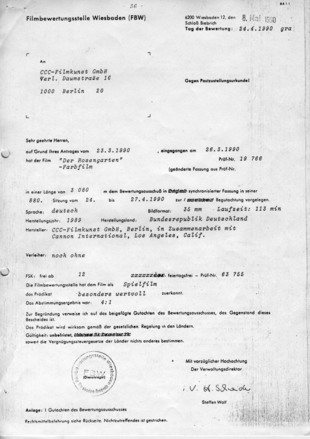
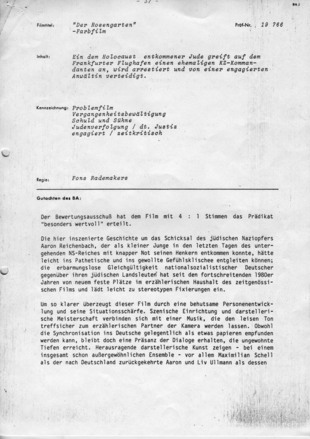
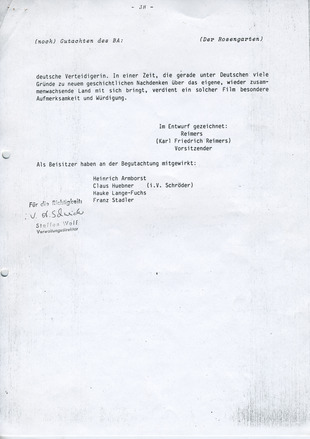
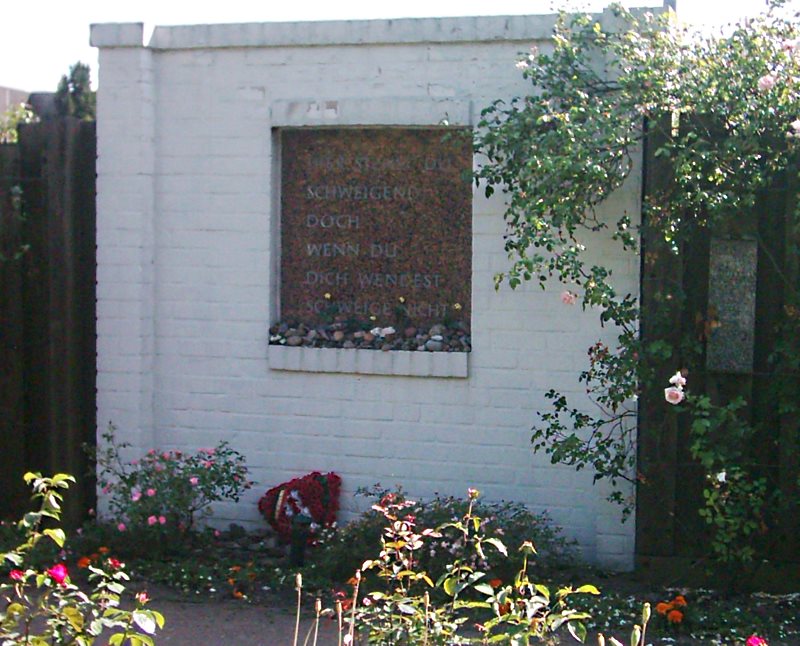
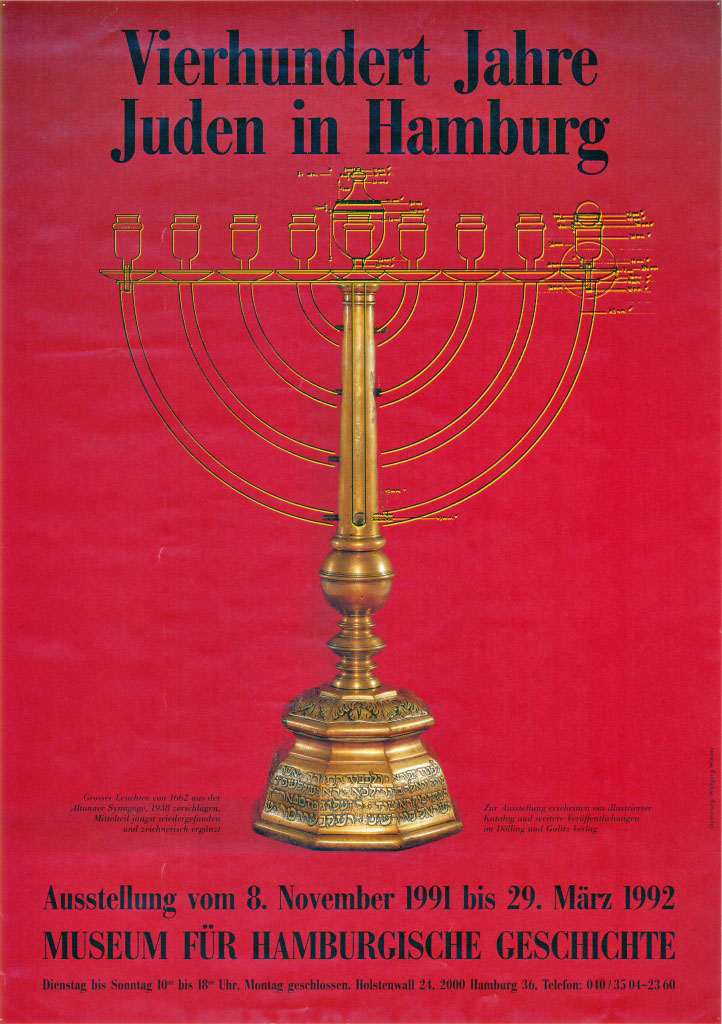
This exhibition emerged from a close cooperation between staff members of the Hamburg Historical Museum, the Institute for the History of the German Jews, and the initiative of former Jewish residents of Hamburg, Bremen, and Lübeck in Israel. As a first result of this cooperation, an exhibition titled “Ehemals in Hamburg zu Hause – Jüdisches Leben am Grindel” [Formerly at Home in Hamburg – Jewish Life in the Grindel Neighborhood] was shown in August 1986 in the auditorium of the former Talmud Torah School. At the time, the building was still used by the library science faculty of Hamburg's Polytechnic School. The exhibit, mainly consisting of display panels, subsequently moved to the Hamburg Historical Museum for another three months. At the same time, research and communication with lenders across the globe continued, and an inventory of Judaica existing in Hamburg museums was compiled.
(Text: Ulrich Bauche)
In 1989 Hebrew scholar Naphtali Bar-Giora Bamberger (1919-2000) visited the Altona Museum’s metal objects depot, where he found a broken, large brass Hanukiah menorah that until then had neither been inventoried nor documented. The octagonal, extensively molded base shows raised Hebrew writing on seven of its eight sides. According to Bamberger's translation it begins: “To honor the creator and to honor the Torah, which is our light, this Chevra has donated this candelabrum. / Our teacher and our rabbi, Rabbi Wolf from Vilna, … .” It ends: “Year 422 LFK.” According to the “Mundane Era” calculation, this dates the inscription to 1662 CE.
The twelve donors listed in the inscription could be identified as Jewish residents of Altona or Hamburg. In 1671 they were among the founders of the triple congregation association, the Hebrew abbreviation for which was “AH'U” for Altona, Hamburg, and Wandsbek. When the “Große Altonaer Synagogue” [Great Synagogue of Altona] was built in 1682 as the center of this triple congregation, it was the largest Jewish prayer house in Germany at the time. It was to be the menorah's home until 1938. The synagogue had been destroyed in 1711 in a wartime fire in Altona, during which the menorah had probably been damaged and rescued. The synagogue was rebuilt and the menorah repaired. Its central stem and the nine branches curved in a quadrant date from a restoration after 1800. When the synagogue interior was destroyed during the 1938 November pogrom, the branches were apparently broken off and subsequently lost.
Although the rediscovered fragment of the menorah represented a powerful historical object in its ruined state, curators decided to reconstruct it. The finished reconstruction is shown on this exhibition poster. The shape of the branches and candle holders could be reconstructed with the help of various photographs taken before 1938, mainly portraits of speakers at the bimah standing right next to the menorah. The museum's coppersmith and metal conservator, Karl-Heinz Budweit, created both the design sketch and the successful brass reconstruction. The new menorah measures 124 x 96 cm.
In the exhibition titled “400 Jahre Juden in Hamburg” [400 Years of Jewish Life in Hamburg] and shown at the Hamburg Historical Museum (1991 / 92), the menorah was displayed prominently and received a lot of attention. The expansive exhibition, which filled most of the galleries on the museum's ground floor, also impressed by the many objects on loan from all over the world.
This photograph shows six stumbling stones embedded in the pavement in front of the residential building at Brahmsallee 13 by artist Gunter Demnig on July 22, 2007. The brass plate-covered concrete cubes measuring 10 x 10 cm remember three Jewish couples who lived at this address: Gretchen and Jona Fels from 1920 until 1935, Bruno and Irma Schragenheim from 1927 until 1936, and Moritz and Erna Bertha Bacharach from 1937 until the spring of 1939. Demnig’s intention in placing these stones is to embed the names of the victims of National Socialism in the memory of people living today. He hopes they will start various kinds of discussions, thus continuously encouraging the study and discussion of National Socialist injustice. Read on >
On October 28, 1661 Ashkenazi Jews from Hamburg bought a burial ground on Holstein territory in the Danish-ruled town of Ottensen. The cemetery had been established on open ground. In the course of the following decades the cemetery's location on the outskirts changed due to beginning settlement. During the Second World War the Wehrmacht built an air raid shelter on the cemetery grounds, which destroyed a significant number of graves. In December 1942 the Reich Association of the Jews in Germany, of which Hamburg's Jewish congregation was a member by this time, was forced to transfer the property to the city as its new owner. Already in the summer of 1945 the congregation, reorganizing itself, demanded restitution of the cemetery site. When the city rejected the claim, the congregation brought a lawsuit before Hamburg's district court (court for restitution cases). The lawsuit was settled by a mutual agreement in 1950 / 51. The congregation and the Jewish Trust Corporation, who considered itself authorized as trustee of former Jewish assets, sold the property to the department store chain Hertie before it was restituted. A department store was eventually built on the site.
A completely new situation arose in 1990 and the following three years. The department store chain Hertie had closed the Ottensen store in 1988 and sold the property to Hamburg property developing firm Büll & Lüdtke, who intended to demolish the existing buildings, including the air raid shelter, and erect a new shopping mall on the lot. (Text: Ina Lorenz)
In order to prevent construction on the site of the destroyed Jewish cemetery in Ottensen, Athra Kadisha, an international society of Hasidic Jews “for the preservation of Jewish holy sites,” organized several protest movements aimed at occupying the construction site. The protesters were made up exclusively of Jews from other European countries, mostly from Amsterdam, and apparently also from Israel and appeared in the traditional black Hasidic dress. The protest movement caused serious clashes with Hamburg police, which was widely reported in the media, as its organizers intended. The protests were meant to attract broad international attention through media coverage and thus exert political pressure on German authorities. In addition to images of violent clashes with the police, it was signs showing slogans like: “Will this cemetery become judenrein?” that received lots of media attention. The image shown here features a sign written in English, which indicates that it was mainly addressed to an audience outside of Germany. Other signs attest to the spreading of disinformation. Whether the Jews joining these protests from abroad were aware of this is unclear. What we know is that the protesters intended to show the international public that in Hamburg a Jewish cemetery containing about 4,500 graves was about to be “thrown out.” In fact the number of burials still remaining in the ground at this time was estimated at 400 to 500. (Text: Ina Lorenz)
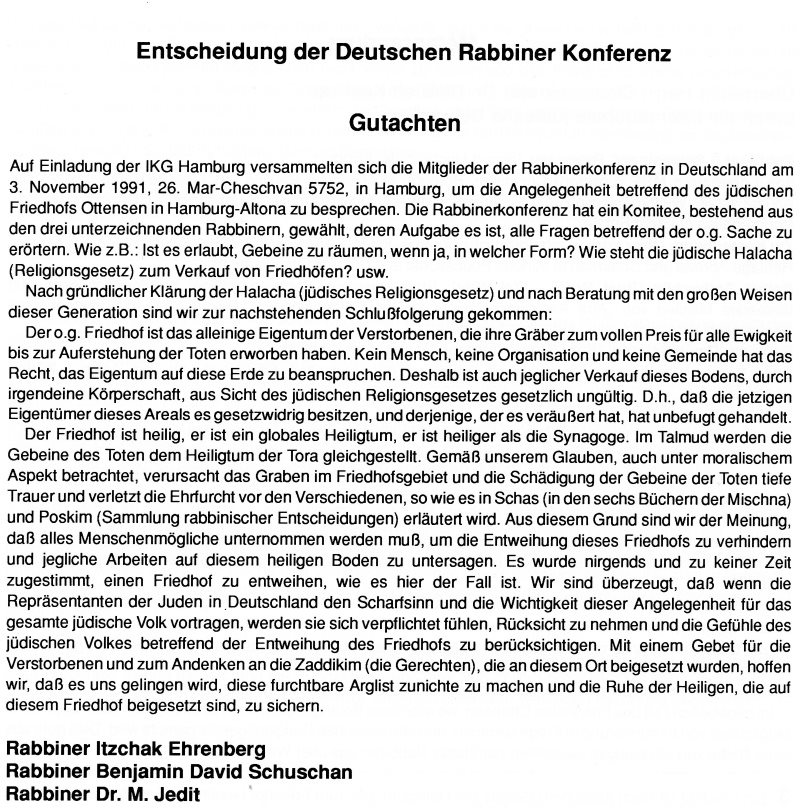
When the conflict about the planned construction on the site of the Jewish cemetery in Ottensen was already in full swing, the German Rabbinical Conference in November 1991 issued an opinion. They judged the construction project as a clear violation of Halakhic law and demanded that all work on the site be halted immediately. This document represents the climax of the conflict, when battle lines were drawn between the city, the developer, and various Jewish groups whose positions were by no means unified, however, and in some cases even contradicted one another. Read on >
Born in Berlin in 1921, Nathan Peter Levinson was educated at the Jewish private school of the Orthodox splinter congregation Adass Jisroel in Berlin and subsequently studied at Berlin’s Lehranstalt für die Wissenschaft des Judentums. In 1941 he emigrated from Germany to the United States. He pursued his rabbinical studies at Hebrew Union College in Cincinnati before returning to Germany in 1950. He was a member of the World Union for Progressive Judaism. In 1964 he became state chief rabbi for Baden as well as for Hamburg and Schleswig-Holstein. Berlin rabbi Andreas Nachama (born 1951) wrote on the occasion of Levinson's 90th birthday in the Jüdische Allgemeine newspaper: “For me he is the last German-speaking rabbi of his generation who indeed still personifies that combination of highest scholarly learning, enlightened academic liberalism, and Jewish-traditional knowledge which the German-Jewish generation of rabbis around Leo Baeck stood for.” The Halakhic decision presented here is in accordance with this eulogy. Its tone is restrained yet decisive. The decision he has arrived at is justified according to the rules of a scholarly response. His reasoning is straightforward, and his arguments are backed by citations. For instance, he refers to the Torah, the Talmud, and the legal code Shulchan Aruch by Safed rabbi Joseph Karo (1488-1575). Since the legal code only discusses the reinterment of individual graves, Levinson adds his own thoughts on the reinterment of an entire cemetery or substantial parts of it. (Text: Ina Lorenz)
Itzhak Kolitz (1922-2003), whose name is sometimes transcribed as “Kulitz,” was born in Alytus, a town on the Nemunas River in southeastern Lithuania. His father was the rabbi there. In 1933, at the age of eleven, Kolitz went to Palestine. He studied the Torah at the Hebron Yeshiva in Jerusalem. In 1955 he became a rabbinical court judge. He was ordained as Ashkenazi chief rabbi of Jerusalem in 1981 and later was also appointed chairman of Jerusalem's rabbinical courts. His decision given in this opinion was not justified by Halakhic law and stood in opposition to both state chief rabbi Levinson’s decision and the statement by the German Rabbinical Conference. read on
Since his opinion, which was published both in the Frankfurter Allgemeine Zeitung and the Allgemeine Jüdische Wochenzeitung newspapers, allowed the construction of the Mercado shopping mall with some limitations, it is considered Solomonic. In order to avoid disturbing the dead, no excavations may be carried out. Therefore a parking lot was built on the building's roof instead of the originally planned garage, and a concrete slab was poured over that part of the ground where graves and remains were still assumed to exist. A memorial wall in the building's basement bearing the names of about 4,000 dead who were once buried here commemorates the former cemetery.
(Text: Ina Lorenz)
This memorandum from the Senate to the City Assembly states that following the arbitration by chief rabbi Kolitz, which had allowed for the building of the shopping mall on the one hand but also imposed some conditions on the other hand, a financial agreement had been reached between the city of Hamburg and the developing firm of Büll & Lüdtke. The city accepted that it had to find an overall solution which compensated the developer for his losses. It was true that the developer was unable to fully realize the building permit he had been granted in 1990 / 1991 if he also wanted to abide by chief rabbi Kolitz' judgment. At the time, none of the parties involved wanted to consider the possibility that the building permit might have been in violation of the law against disturbing the dead in the first place. Thus the developer was the one who truly benefited from the conflict in the end. He had acquired the site of the former cemetery for 14.2 million D-Mark, got to keep it and received 16.4 million D-Mark in “compensation,” and he also now owned two properties on Große Elbstraße in an attractive location, which he had also received as compensation. (Text: Ina Lorenz)
This photo shows the memorial wall in the staircase of the Mercado shopping mall leading from the ground floor to the basement. It reads “We remember the dead who were buried in the Jewish cemetery in Ottensen.” The plaques mounted in 1996 provide information about the history of the Jewish cemetery in Ottensen and list the names of about 4,500 dead who were buried there. In May 1990, political committees in Altona had still discussed turning remaining parts of the cemetery into a public memorial. However, this morally and politically worthy cause was increasingly sidelined in subsequent months. One reason for this might have been that the Jewish congregation did not show any interest in it. Well-meaning initiatives flagged, and the memorial idea was reduced first to a memorial space, then a monument, and finally a plaque. It is up to the Jewish self-conception to judge whether in the long term the solution found by chief rabbi Kolitz confirms, preserves or reinforces the dignity that Jewish religious law assigns to every Jewish cemetery “for time eternal.” (Text: Ina Lorenz)
Esther Bauer (1924–2016) was born in Hamburg. She was the only child of Alberto Jonas, the director of the Israelite School for Girls, and physician Marie Jonas, née Levinsohn. She grew up in a sheltered environment and initially remained largely unaware of National Socialist persecution. In 1940, however, the family was forced to move out of their spacious apartment in Hamburg’s neighborhood of Eppendorf and had to move into a so-called “house for Jews” [Judenhaus]. In July 1942, her family was deported to Theresienstadt, where her father died soon after. Esther Bauer fell in love with Czech camp inmate Hanuš Leiner and married him. When her husband was deported to another camp in 1944, she volunteered for a transport. Esther Bauer ended up in Auschwitz-Birkenau and, a few days after her arrival, was assigned to forced labor in the satellite camp at Freiberg. She never saw her husband again. In 1945, nearly starved to death, she was forced on a death march. She witnessed the liberation at the KZ Mauthausen. Her mother had been murdered at Auschwitz-Birkenau.
Esther returned to Hamburg, where the occupation authorities assigned her a room in her parents’ old apartment in Eppendorf. The man who had taken over the apartment after her family was forced to move into the “Judenhaus” still lived there as well, however. Due to this unbearable situation, Esther emigrated from Hamburg to the United States a short time later. She married again and first worked in her husband’s textile business and later in a large advertising agency.
This photo shows Esther Bauer, née Jonas (Esther Bauer was born Esther Jonas; after her first marriage she took the name Esther Jonas-Leiner; in the United States she took her second husband's name and called herself Esther Bauer) with an unknown friend at the Mauthausen concentration camp. After having endured forced labor in the Freiberg satellite camp, she had come to Mauthausen on a death march in spring 1945 and witnessed the camp's liberation by U.S. troops in May 1945. (Text: Lena Langensiepen)
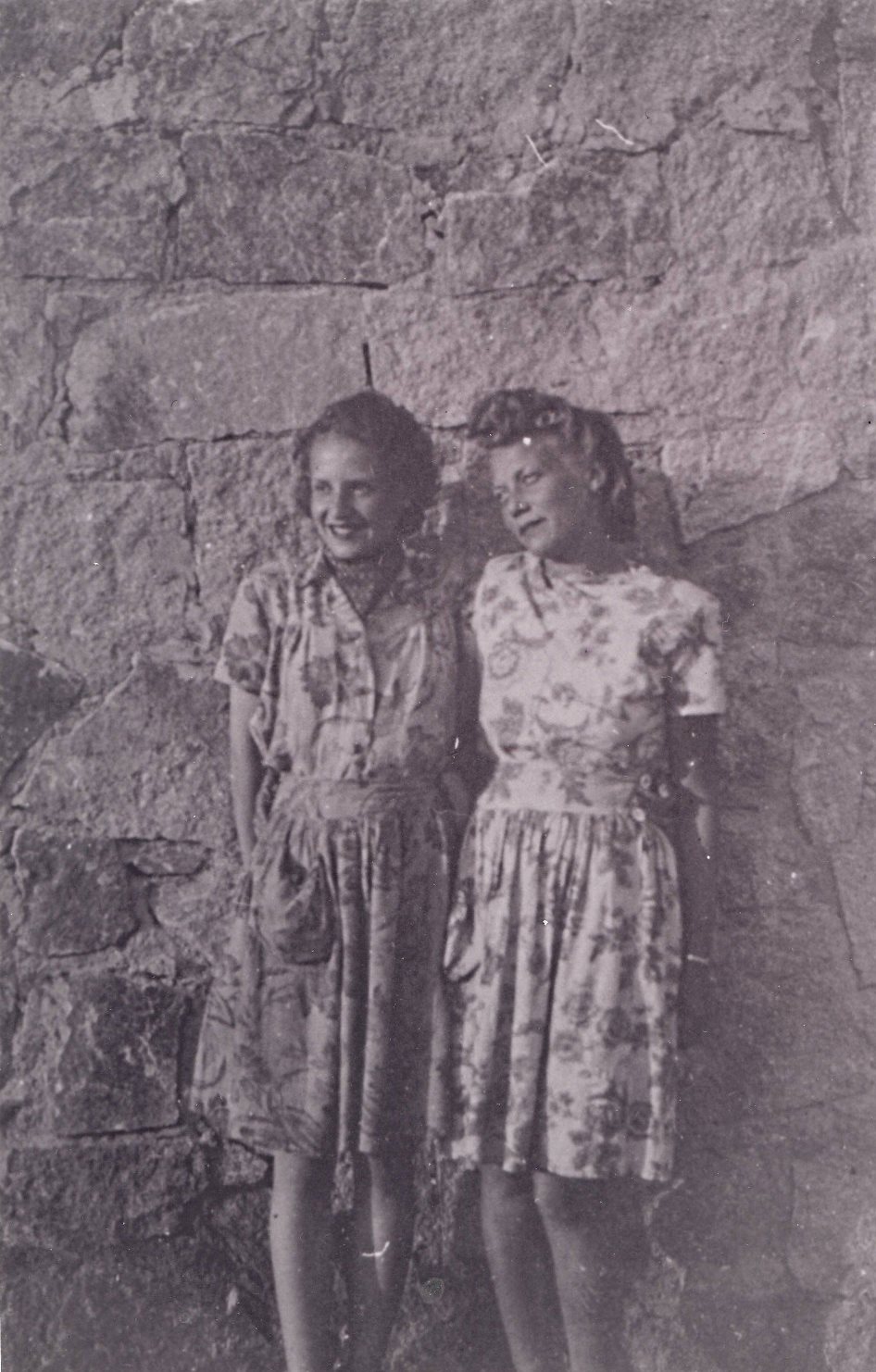
After she had witnessed liberation by the Allies in the Mauthausen concentration camp near Linz (Austria), Esther Bauer returned to Hamburg. The British occupation authorities allocated her a room in her parents’ former apartment at Woldsenweg 5 in the Eppendorf neighborhood. Yet the man who had moved into the apartment when Esther's family had to move into a so-called “Jewish house” in 1940, a Dr. Schwarke, still lived there. Given this unacceptable situation, Esther left Hamburg and soon afterwards emigrated from Germany to the United States. (Text: Lena Langensiepen)
This is an excerpt from an oral history interview with Esther Bauer conducted on November 20, 1998 by Jens Michelsen for Workshop of Memory (WdE), the Oral History Archive run by the Research Centre for Contemporary History. It is the second of five interviews with Esther Bauer archived at WdE. The interview was initiated by Esther Bauer during her visit to Hamburg on the occasion of the Gedenk- und Bildungsstätte Israelitische Töchterschule being named for her father, Alberto Jonas, on November 9, 1998. Read on >
Esther Bauer’s life story inspired stage director Christiane Richers to write the plays “Esther Leben” [Esther Life] (2006) and “Das ist Esther” [This is Esther] (2007), which are still being staged in Hamburg in various versions today. This video shows a clip from a production of “Esther Leben” by the Thalia Treffpunkt / Thalia Theater directed by Herbert Enge and performed at Kellinghusen Park in the Eppendorf neighborhood in 2006. (Text: Lena Langensiepen)
Esther Bauer lived in the United States for many years. She kept returning to Hamburg and played a major part in ensuring that the city of Hamburg remembers her history and that of her family. In the 1980s she saw to it that the former Israelite Girls School, which has been used by the local Volkshochschule [adult education center] as a memorial and education center since 1988, was named after her father. She also campaigned successfully to have a square in Hamburg-Eppendorf – which is shown in this photo – named after her mother, Marie Jonas. (Text: Lena Langensiepen)
On numerous occasions in both Germany and the U.S., Esther Bauer publicly talked about her experiences as a victim of National Socialist persecution. She was awarded the Federal Cross of Merit for her commitment in 2007. This video shows her as a participant in an oral history conversation, which was recorded at the Jewish Salon at Grindelhof in November 2011. The conversation was part of the project “Wie wollt ihr euch erinnern?” [How do you want to remember?] organized by the Neuengamme concentration camp memorial and Hamburg high school students. (Text: Lena Langensiepen)
It is only in the recent past and not least due to the influence of migration from the countries of the former Soviet Union that the beginnings of a more diverse approach towards living one’s faith have been emerging. The establishment of an egalitarian prayer circle, the Liberal Jewish congregation founded in 2004, the conservative Masorti congregation of Kehilat Beit Shira existing since 2009, as well as the center run by the international ultraorthodox group Chabad Lubawitsch all testify to the desire to again establish different religious positions in Hamburg in the hope that they will endure. (Source: Introductory Text: Religion and Identity)
In a short article, Daniel Killy reports about the opening of the Joseph Carlebach School located at Grindelhof 30, which opened its doors to 18 children attending preschool and first grade on August 28, 2007. He describes the daily routine and the concept of “rhythmicization,” meaning the multi-methodical composition of the school day at this all-day school, which follows the ideas of pedagogue Joseph Carlebach, for whom the school is named. In addition to principal Heinz Hibbeler, Killy quotes rabbi Shlomo Bistritzky, who highlights the significance of this new school for the rebuilding of Jewish life in Hamburg. Read on >
Jewrovision exists since 2002, and in 2013 the Central Council of Jews in Germany began hosting Europe’s biggest Jewish dance and song contest in different cities. In 2018 the Jewrovision contest took place in Dresden. Prior to the event, participants produce an introduction video about their city, their congregation, and their youth center – as did the 2017 winner, the Chasak youth center of Hamburg’s Jewish congregation. During the contest, the videos are shown in addition to the actual show act.
Opened in 2008 at Café Leonar, the Jewish Salon is an expression of a diverse Jewish culture once again becoming visible. Based on the idea of the salon, it aims to provide a space for discussion and reflection. How this can be achieved in the twenty-first century and which role the time before 1933 plays in it were among the questions four students of Hamburg’s Sophie-Barat-School discussed with Michael Heimann, one of the salon’s founders, as part of a “Geschichtomat” project week.
This photograph, showing the “Corina” wedding gown, is taken from the official website of Israeli fashion designer Galia Lahav. The princess-like tiara, the corset with floral embellishments, and the voluminous tulle skirt are staged in a fairy tale setting. The image is representative for fashion company Galia Lahav’s claim to combine luxury, elegance, and romance in its bridal fashion. Perhaps this was one of the reasons why this photograph was chosen as illustration for an entry in the local wedding guide “Kuchenbuchs Hochzeitskatalog” [Kuchenbuch’s Wedding Catalog] entitled “True Haute Couture in Hamburg” (pp. 48-51), which reports on Galia Lahav’s bridal fashions while pointing out that the first European flagship store of the Israeli company was opened in 2016 at Mittelweg 21a in Hamburg. Read on >
Conception: Anna Menny. Technical Implementation: Daniel Burckhardt. Translation: Insa Kummer
As of: December 12, 2018.
